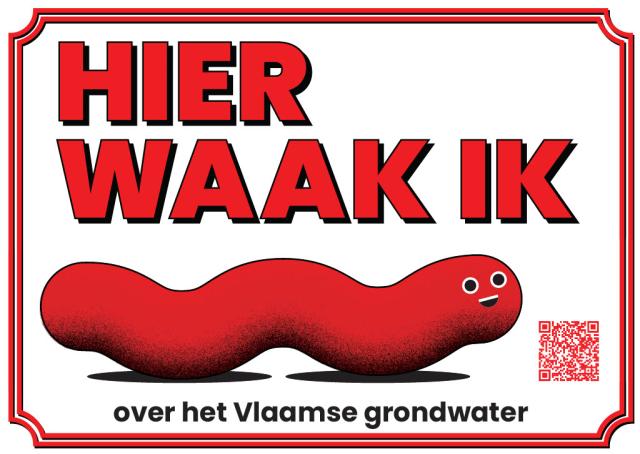Local authorities in Flanders are encouraged to draw up rainwater plans. These plans need to present a detailed vision of how they intend to use rainwater as an alternative water source, to capture it and allow it to infiltrate the source, store it in buffer zones and/or slow down its drainage rate. The need to switch from rapid drainage to capture is widely acknowledged. In practice, the needed switch is happening (too) slow. Besides the fact that only a limited number (10%) of municipalities have a rainwater plan, these plans still strongly put the emphasis on water drainage.
One phenomenon, which will delight Scrabble fans, remains out of the picture for the time being: evapotranspiration. You could describe it as the sweating of the soil and plants. And this evaporation process plays a more important role in the system than many people suspect or realise.
Approximately half of the water available every year in Flanders comes from rainwater (the other half is water flowing into Flanders via rivers). And here’s the thing: 70% of the water that falls on our territory evaporates! Around 25% penetrates into the soil, and 5% drains away (through watercourses and sewers). Furthermore, climate scenarios suggest that in future summer periods, more water will evaporate on the surface and from the soil than will fall as rain. And the disparity is only going to expand, because summer rainfall will decrease and evaporation will increase.
Evaporation in itself is not necessarily a problem. But due to the extent of it, it at least merits an exploratory question at a time when it is becoming increasingly difficult to meet our water needs.
Evaporation is determined by various factors. For instance, the type of greenery and vegetation, and their specific growth stage; the types of soil cover for paved surfaces, humidity and solar radiation, and temperature and wind. Each of these factors could be an answer in bringing down evaporation losses.
Is evaporation significant then, one might ask? To give an idea of the order of magnitude: the water we use in Flanders is 10% of what evaporates. So there is considerable potential here to make our water management more robust. This doesn’t have to be complicated or expensive. Natural windbreaks can help for example, such as hedges or rows of trees, because less wind means less evaporation. Porous road surfaces help by creating a cooling effect. When trees, plants and crops are planted, the evaporation characteristics could be examined in more detail (the popular poplars, for example, sweat away a significant amount of water compared to other trees). Applying soil improvers that store water in the soil faster and more effectively, thereby slowing down evaporation, could also help. But wildlife can also offer a solution: earthworms help the soil to capture and hold water. Taking care of the earthworm population could then help in this regard.
Evaporation is therefore a significant element in our water management, and it can be tamed by simple measures. Tamed, because we don’t want evaporation to stop completely. Evaporation provides humidity and cooling, and we need that to make life comfortable. It creates clouds, which in turn offer shade, or retain heat at night, and so on. That is why it is especially important to look at where slowing down evaporation can also provide other added value. Trees instead of a lawn in the garden inhibit evaporation, and enhance biodiversity simultaneously. Greenery in a city cools it down, thereby taming the evaporation of paved surfaces, but at the same time contributing to well-being and liveability, and water buffering.
Although evaporation has long been an issue in warm, desert-like areas, it seems to have stayed under the radar in Flanders. This could be due to various aspects of the water policy as identified in the arena process. First of all, calamities in the water system, floods, serious damage to water quality, and major water shortages turned out to be strong drivers for policy agendas. And evaporation does not cause disasters. Nor does it have any impact on infrastructure, or cause any visible damage. The instinct to control and manage, often using infrastructure, which would characterise water policy in many areas, is not applicable to the problem of evaporation. It requires a more proactive and integrated vision of the water system, which results in ideas for effective management of earthworm populations instead of concrete sewer pipes with a diameter that can be calculated. You could say it is a matter of having a different mindset, and for that very reason it is interesting and relevant to explore further.
We want to gain better insight into the issue of evaporation, and by experimentation, build a better understanding of the potential of evaporation as a solution.
Creative campaign: Worms are the new dogs (in Dutch)
What if.... we promoted worms as ideal pets to improve Flanders' groundwater infiltration?
Download all catalysts
Disclaimer
The Flemish Environment Agency (VMM), De Vlaamse Waterweg, De Watergroep, Aquafin, the Flemish Department of Environment, Farys, Pidpa, water-link and VITO - Vlakwa have created the space for a group of fresh thinkers to develop a systemic view of water, and to challenge the water sector to shape a futureproof water system. The formulated ideas are not those of the initiators, nor do they represent their stands. However, they are considered valuable as an inspiration for the future of our water system.
This work is licensed under a Creative Commons Attribution 4.0 International License.

